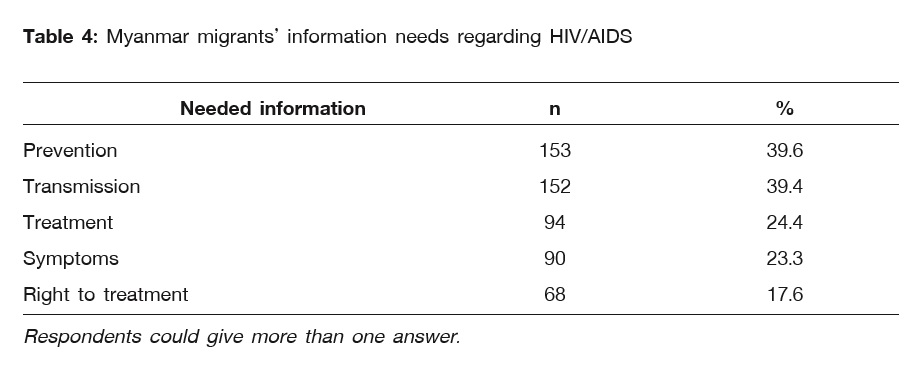MYANMAR MIGRANTS’ ACCESS TO INFORMATION ON HIV/AIDS IN THAILAND
Main Article Content
บทคัดย่อ
Purpose : It was estimated that 3.6 million migrants in Thailand were from Myanmar. The health communication interventions were not effectively designed for this population due to lack of information on how Myanmar migrants’access to HIV/AIDS information. The purpose of this study was to evaluate the Myanmar migrants’ access to information on HIV/AIDS in Thailand.
Methods : A self-assessed structured questionnaire was administered to 386 Myanmar migrants in Thailand to obtain data on the migrants’ proficiency in the Thai language, their sources of information on HIV/AIDS, the relative contribution of print and electronic media in providing them with knowledge on HIV/AIDS, their main interests in HIV/AIDS, the potential obstacles to their acquisition of public health knowledge, and their preferred sources for learning about HIV/AIDS.
Results : Myanmar workers have a poor command of the Thai language. Their primary sources of information are non-governmental organizations (NGOs), friends, and coworkers. They prefer to be informed about the prevention and transmission of HIV/AIDS in their factory and the hospital. The migrants did not understand information as it was in Thai language.We also found that 67.9% of the respondents used Facebook.
Conclusion : The language barrier was one of the main factors affecting Myanmar migrants’ access to information about the prevention and treatment of HIV/AIDS. HIV/AIDS prevention and treatment strategies should be accustomed to being acceptable and understandable for Myanmar migrants. In addition, the means and technique for disseminating knowledge should be appropriated regarding preferred educational channels and language.
Article Details
เอกสารอ้างอิง
Barnett, E. D., & Walker, P. F. (2008). Role of immigrants and migrants in emerging infectious diseases. Med Clin North Am,92(6), 1447-1458, xi-xii. doi:10.1016/j.mcna.2008.07.001
Bertrand, J. T., O’Reilly, K., Denison, J., Anhang,R., & Sweat, M. (2006). Systematic review of the effectiveness of mass communication programs to change HIV/AIDS-related behaviors in developing countries. Health Education Research, 21(4), 567-597. doi:10.1093/her/cyl036
Brislin, R. (1986). The wording and translation of research instrument. In W. J. Lonner & J. W. Berry (Eds.), Field methods in cross-cultural research (pp. 368 p.). Beverly Hills: Sage Publications.
Cao, B., Gupta, S., Wang, J., Hightow-Weidman, L. B., Muessig, K. E., Tang, W., . . . Tucker, J. D. (2017). Social Media Interventions to Promote HIV Testing, Linkage, Adherence, and Retention: Systematic Review and Meta-Analysis. Journal of Medical Internet Research, 19(11).
Cronbach, L. J. (1951). Coefficient alpha and the internal structure of tests. Psychometrika,16(3), 297-334.
Digital in Southeast Asia in 2017. (2017). Retrieved from: https://wearesocial.com/special-reports/digital-southeast-asia-2017
Foreign Workers Administration Office. (2017). Journal of ASEAN Migrants figures in December 2017 Retrieved from: https://www.doe.go.th/prd/assets/upload/files/alien_th/0cd4d176bfb03045a0304e2e5179d087.pdf
Ko, E., Zúñiga, M. L., Peacher, D., Palomino, H., & Watson, M. (2018). Efficacy of cancer care communication between clinicians and Latino patients in a rural US-Mexico border region: a qualitative study of barriers and facilitators to better communication. Journal of Cancer Education,33(1), 116-127.
Kyu, H. H., Thu, M., & Van der Putten, M. (2005). Myanmar migrant woman caretakers on prevention of dengue fever: A study on knowledge, attitude and practices in Tak Province, Thailand. Hospital, 27, 9.9.
Leiter, K., Suwanvanichkij, V., Tamm, I., Iacopino, V., & Beyrer, C. (2006). Human rights abuses and vulnerability to HIV/AIDS: the experiences of Burmese women in Thailand. Health Human Rights, 9(2), 88-111.
Lionis, C., Papadakaki, M., Saridaki, A., Dowrick, C., O’Donnell, C. A., Mair, F. S., . . . de Brún, M. O. R. (2016). Engaging migrants and other stakeholders to improve communication in cross-cultural consultation in primary care: a theoretically informed participatory study. BMJ open, 6(7), e010822.
Meuter, R. F., Gallois, C., Segalowitz, N. S., Ryder, A. G., & Hocking, J. (2015). Overcoming language barriers in healthcare: A protocol for investigating safe and effective communication when patients or clinicians use a second language. BMC Health Services Research, 15(1), 371.
Myanmar National Strategic Plan on HIV and AIDS. (2010). Retrieved from: https://www.jhsph.edu/ research/centers-and-institutes/centerfor-public-health-and-human rights/_pdf/ NSP%20Full%20Book%20Final.pdf.
Patcharanarumol, W., Thammatacharee, N., Kittidilokkul, S., Topothai, T., Thaichinda, C., Suphanchaimat, R., . . . Tangcharoensathien, V. (2013). Thailand’s HIV/AIDS program after weaning-off the global fund’s support. BMC Public Health, 13,1008. doi:10.1186/1471-2458-13-1008
Penetration of leading social networks in Thailand as of 3rd quarter 2017. (2018).Retrieved from: https://www.statista.com/284483/thailand-social-network-penetration/
Pengpid, S., Peltzer, K., Puckpinyo, A., Tiraphat, S., Viripiromgool, S., Apidechkul, T., . . . Mongkolchati, A. (2016). Knowledge, attitudes, and practices about tuberculosis and choice of communication channels in Thailand. The Journal of Infection in Developing Countries, 10(07), 694-703.
Press, B. (2011). The PHAMIT story: The experience of an HIV preventive project for migrant workers in Thailand (S.Baker Ed.). Bangkok: Rak Thai Foundation. Social Media Movement. (2016). Retrieved from: https://thailandzocialawards.com/download-slides/Social-Media-Movementby-Pnern-Asavavipas.pdf
Sudore, R. L., Landefeld, C. S., Perez-Stable, วารสารวิทยาศาสตร์การกีฬาและสุขภาพ ปีที่ 21 ฉบับที่ 1 (มกราคม-เมษายน 2563) 123 E. J., Bibbins-Domingo, K., Williams, B. A., & Schillinger, D. (2009). Unraveling the relationship between literacy, language proficiency, and patient–physician communication. Patient Education and Counseling, 75(3), 398-402.
Suphanchaimat, R., Sommanustweechai, A., Khitdee, C., Thaichinda, C., Kantamaturapoj, K., Leelahavarong, P., . . . Putthasri, W. (2014). HIV/AIDS health care challenges for cross-country migrants in low- and middle-income countries: a scoping review.HIV AIDS (Auckl), 6, 19-38. doi:10.2147/HIV.S56277
Yamane, T. (1973). Statistics: An Introductory Analysis. New York : Harper and Row Publication. UNAIDS. (2017). Fact sheet: World AIDS day 2017.
Weine, S. M., & Kashuba, A. B. (2012). Labor migration and HIV risk: A systematic review of the literature. AIDS and Behavior,16(6), 1605-1621. doi:10.1007/s10461-012-0183-4
Wen, Y., Wang, H., Chen, B., Chen, Y., Zhang,T., Xu, T., & Sun, W. (2015). Association of information sources and knowledge on HIV/AIDS in rural china. International Journal of Collaborative Research on Internal Medicine & Public Health, 7(2), 13.
WHO. (2007). Health of migrants-report by the secretariat. Executive Board, 122nd Session, Provisional agenda item 4.8 Retrieved from https://www.who.int/hac/techguidance/health_of_migrants/B122_11-en.pdf.


